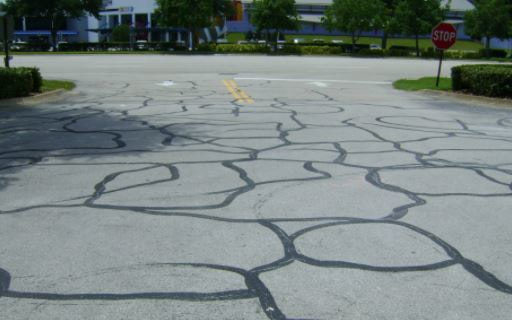|
Pavement Crack Filling Contractors
Cracks occur when pavements age and traffic pounds them. If not maintained and repaired timely, this may lead to potholes that later become craters. Thorough maintenance in performed and all cracks are sealed before more damage occurs. Taking care of your pavement, guarantees you a long lasting solutions and beautiful driveways.
How to fill cracks in driveways Using a blower or a broom, sweep the driveway then clean oil stains with degreaser before filling. Also pluck all visible weeds between cracks and make sure the driveway is completely dry before filling cracks and sealing. HMA is the same material we use in construction, which means repair-work done this way is high-quality and permanent when properly carried out. First, the crack must be cut into shape and primer added onto the base. Next, a HMA truck will pour the hot mix on the shaped hole, and the lane mustn’t be used until curing and compacting is complete. HMA trucks have to carry tons of material, and hence the process isn’t economically viable to repair a few scattered cracks. In addition, this procedure cannot be carried out during cold or rainy weather, which is when most cracks form. Call 574-807-6961 For A Free Estimate |
|
pavement Crack filling Company - Call 574-807-6961
What do you use to seal cracks in walls?
Having cracks on your beautiful wall may be a cosmetic problem or an indication of a more serious structural issue. It is important to first identify the type of the wall and also the depth of the crack on the wall before fixing it. Cracks on the walls are common but can be unsightly on a well decorated wall. These cracks are caused by movement and are common in newly built homes. Crack sealing is the process of covering the cracks that have occurred on the walls.
The easiest way to deal with a crack on the wall is to use interior crack fillers that are commonly available in local hardware stores. When filling cracks, enlarge the crack around the edges slightly using a utility knife so it becomes easier to apply crack filler and scrape away the excess using a scraper. If the wall is painted, let it dry and repaint the part that has been repaired.
Having cracks on your beautiful wall may be a cosmetic problem or an indication of a more serious structural issue. It is important to first identify the type of the wall and also the depth of the crack on the wall before fixing it. Cracks on the walls are common but can be unsightly on a well decorated wall. These cracks are caused by movement and are common in newly built homes. Crack sealing is the process of covering the cracks that have occurred on the walls.
The easiest way to deal with a crack on the wall is to use interior crack fillers that are commonly available in local hardware stores. When filling cracks, enlarge the crack around the edges slightly using a utility knife so it becomes easier to apply crack filler and scrape away the excess using a scraper. If the wall is painted, let it dry and repaint the part that has been repaired.
Best pavement crack filling - Call Us At 574-807-6961

What is sealcoating driveways?
This a processing of applying an emulsion type product over the already constructed pavement. The product is applied to prevent additional damages to the pavement by chemical and weather that come in contact with the parking area or driveways. Seal coating can be applied later after the initial pavement has been placed to allow cure and wear of the surface.
Crack sealer materials and equipment
Sealants are selected based on pavement condition, movement and climate. Cooler climates require more flexible sealants than hotter climates. Using softer material in hot climates may cause tracking of the material by either cars or pedestrians. Using flexible materials in cooler climates will expose the pavement to greater temperature swings and may crack prematurely. Also use flexible material on pavements that are less busy and stiffer sealant on pavements with high crack density.
This a processing of applying an emulsion type product over the already constructed pavement. The product is applied to prevent additional damages to the pavement by chemical and weather that come in contact with the parking area or driveways. Seal coating can be applied later after the initial pavement has been placed to allow cure and wear of the surface.
Crack sealer materials and equipment
Sealants are selected based on pavement condition, movement and climate. Cooler climates require more flexible sealants than hotter climates. Using softer material in hot climates may cause tracking of the material by either cars or pedestrians. Using flexible materials in cooler climates will expose the pavement to greater temperature swings and may crack prematurely. Also use flexible material on pavements that are less busy and stiffer sealant on pavements with high crack density.



